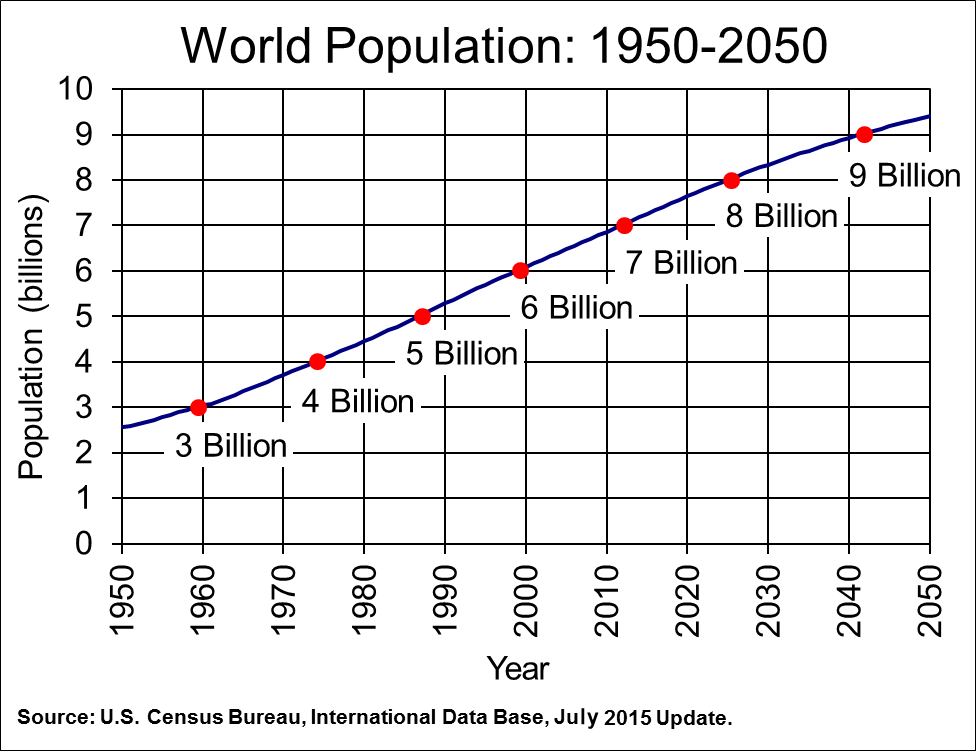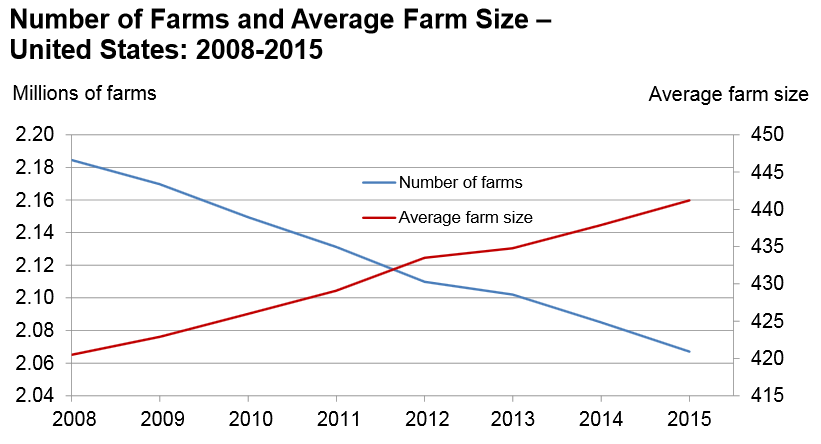
The world population increased from 3 billion in 1959 to 6 billion by 1999, a doubling that occurred over 40 years. The Census Bureau’s latest projections imply that population growth will continue into the 21st century, although more slowly. The world population is projected to grow from 6 billion in 1999 to 9 billion by 2044, an increase of 50 percent over the next 45 years. Source US Census Bureau
One of the areas of critical concern world-wide is how to meet the food demands for a growing world population while farmland acres continue to shrink. As you can see from the chart above, the U.S. Census Bureau is currently predicting that the world population will actually reach 9 billion by 2044. The United States is one of the world leaders in food production and is also expected to grow from 322 million in 2015 to 389 million by 2050. There are some major challenges ahead because we don’t have more land, so as the population grows, farmland acreage will continuously decline. The United States Department of Agriculture (USDA) released their annual Farms and Land in Farms report this week. I was not familiar with this particular annual report, but the numbers are concerning. According to USDA’s estimates 6.6 million acres of US Farmland has been lost from 2008 through 2015, with a 1 million acre decline last year alone. Closer to home USDA estimates that both Alabama and Georgia lost 100,000 acres last year, and 50,000 acres were lost in Florida in 2015. The US farming base has shrunk 7% in eight years, yet the world population is continuously growing.
The United States Department of Agriculture (USDA) released their annual Farms and Land in Farms report this week. I was not familiar with this particular annual report, but the numbers are concerning. According to USDA’s estimates 6.6 million acres of US Farmland has been lost from 2008 through 2015, with a 1 million acre decline last year alone. Closer to home USDA estimates that both Alabama and Georgia lost 100,000 acres last year, and 50,000 acres were lost in Florida in 2015. The US farming base has shrunk 7% in eight years, yet the world population is continuously growing.
 The number of farms has also declined over the past eight years by an estimated 117,500 farms. The average farm size has increased by 20 acres, which indicates that there is some consolidation, so fewer total farm owners with larger farms. This is a trend that has been ongoing since World War II, but as the average farm size grows, it also becomes that much harder for a young family to get started with a farming operation.
The number of farms has also declined over the past eight years by an estimated 117,500 farms. The average farm size has increased by 20 acres, which indicates that there is some consolidation, so fewer total farm owners with larger farms. This is a trend that has been ongoing since World War II, but as the average farm size grows, it also becomes that much harder for a young family to get started with a farming operation.
So what can be done to feed a growing population with fewer farmers and shrinking farmland acreage?
-
Improve Productivity
To feed a swelling population both the productivity and efficiency of existing farms is going to have to improve significantly. In the March Issue of Farm Bureau Bureau’s FloridAgricutlure an article written by Rachael Smith estimates that agricultural production will need to double over next 36 years to meet the demands of 9 billion people. Certainly technology will continue to play a major role in this progress. Commercial industries will continue to invest in the development of better machinery, chemicals, and crop varieties, but not every needed advancement has major profit potential. Research in things like irrigation and fertilizer management, pest and disease management, integrated crop rotation, cover crops, and many other topics of importance to boost productivity will likely not be areas of major corporate research investment. It will take considerable public investment into the science of agriculture to feed a growing population both in the US and abroad. The President’s Council of Advisors on Science and Technology December 2012 report recommended an increase in investment of $700 million per year by the U.S. to prepare to meet the food demands of the growing population. In an era where the popular sentiment is to reduce government spending, this is one area that will require a significant increase in investment in both USDA and Land Grant University research, or food may become scare and expensive.
-
Improve Farm Income
Producing more is not the only answer. because of the combination of increased production creating surpluses of most the major commodities, the strong U.S. dollar, and weak economies in China and other major export markets U.S. farms are dealing three years of low farm income. Current farm policies are primarily aimed at producing inexpensive food and providing a safety net to keep farms in business during periods of weather disasters, but more attention has to be placed on consistent income to keep farms going for generations. Farmers should not be paid just to farm, but policies are needed to keep average farm family income equal to or higher than non-farm family incomes. If we want future generations to take an interest in farming, there has to be better opportunity to be financially successful.
-
Keep Current Farms in Production
There are some programs designed to help protect farm land from development, but there are some real challenges to make this work on a farm-by-farm basis. If the development rights are purchased by the government, then the farm must have a long-term management plan to utilize those funds in some sort of trust. Otherwise a farm will have given away the very collateral they may need for future capital. Our farmers are also getting older. According to the most recent Ag Census, the average age of the U.S. farmer was 58 years old in 2012, and the number of farmers under age 55 had declined from the previous census in 2007. The future of the agricultural industry hinges on the ability to attract younger farmers and to keep current farms in production. This is not an easy process, especially if the farm is going to be passed down from one generation to the next in the same family, without land sales to fiance retirement and debt recovery.
The first two needs identified above are huge. It will take everyone involved with agriculture working together to address these issues with policy makers at the national and state levels. However, the key decisions about the future of productive farms lies in the hands of those who currently own and manage them. This is something every farm family must work on together. This is also not a do-it-yourself type project. It takes the help of a professional estate planner to ensure a legal trust is created that will hold up in court if necessary.
There is no single, simple recipe for successful farm estate planning. Everyone in the family has to work together to develop a plan and then work with professionals to establish the trust that can chart the future of the farm for future generations. Nobody enjoys estate planning, but if you don’t make the time and exert the effort, farms will eventually be sold off to the highest bidder. That bidder may not be a larger farm, but instead may be a land investor who is more concerned with profits than a legacy of farming.
UF/IFAS Extension has begun to offer educational programs to help farm families get this process started.There is an upcoming workshop on this topic: Farm Estate Planning: What will happen to Your Farm? that will be held in Quincy on Thursday, March 31, 2016. Even if you are really not sure what your family wants to do at this point, the speakers will help you ask the right questions so a plan can be discussed with the family before seeking the help of a lawyer who specializes in this type of work.
The bottom line is that everyone associated with the agricultural industry has a major challenge ahead. The world population is growing, farm acreage is shrinking, and fewer people are willing to take the risk to spend a lifetime farming. Having enough food for more than 9 billion people in the next 30 years will require significant investment in innovation, a major boost in both productivity and profitability, and doing everything we can to keep our current farmland in production.
